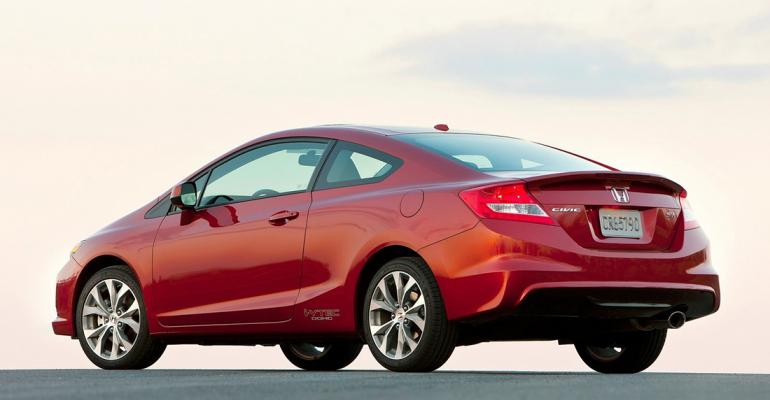Is America’s love affair with the C-car over?
It certainly seems things are trending in that direction.
The 6.0% decline in WardsAuto’s Upper Small segment in February marked the sixth straight month of losses for the U.S. group, home to some of the best-known and highest-volume nameplates in the industry, including the Honda Civic, Toyota Corolla, and Ford Focus.
While some compacts have been able to buck a downward trend – Hyundai’s Elantra has been up five of the past six months, most nameplates are off a little or a lot.
The Subaru Impreza, Volkswagen Jetta, Dodge Dart, Mazda3 and Focus struggled in the September through February period. Declines ranged from about 3.0% for the Impreza and Jetta to double-digit percentage plunges for the Dart and Focus.
FiatChrysler announced March 3 it is temporarily laying off 325 workers at the Dart’s Belvidere, IL, assembly plant the first week of March due to bulging inventory.
But even the usually consistent players are having a tough time.
Toyota’s Corolla, the No.2 best-selling compact in the U.S., also has seen reduced demand, despite being all-new for ’14.
After the late-September launch of the ’14 model, the nameplate recorded just two monthly increases, 8.7% in October and 1.2% in February.
Bob Carter, senior vice president-automotive operations for Toyota Motor Sales U.S.A., told WardsAuto in January that higher-than-usual incentives on the Corolla’s top rival, the Civic, were having a detrimental effect.
“(Honda had) $2,500 cash on a Civic (in December) plus a $3,000 stair-step, hit-your-number (dealer incentive),” Carter said.
But even sales of the Civic haven’t been immune, falling four of the past six months, from a minor dip of 0.3% in January to a deficit of 15.9% in November.
Some CUVs Doing C-Car-Like Volume
So where are C-car buyers going? The most obvious path seems to be C-size CUVs.
Sales in WardsAuto’s Small CUV group are red-hot, with increases in the range of 26.1% to 38.1% in the September 2013 through February 2014 period.
Middle CUVs, where some of the bigger, more expensive C-segment CUVs live, saw smaller increases of 3.0% to 16.3% in the same six months.
Some compact CUVs are starting to do C-car-like volume.
In 2013, Honda’s CR-V surpassed the 300,000-mark for the first time in a calendar year, volume that has been more typical of the Civic and Corolla.
And while the Corolla registered small or no increases in the past six months, Toyota’s RAV4 CUV, redesigned for ’13, enjoyed strong gains over its predecessor.
RAV4 sales were up 52.0% in December vs. like-2012, and February’s tally, 16,451 units, was an all-time record for the month, Toyota says.
The No.1 Japanese automaker has set its sights on selling 250,000 RAV4s in the U.S. annually, either in 2014 or 2015.
There’s evidence the popularity of compact CUVs also might be having a negative impact on midsize cars.
Mazda North American Operations CEO Jim O’Sullivan says his brand is not seeing the typical move-up from C-cars to D-cars, but rather buyers going sideways into a C-size CUV.
He’s buoyant about sales of Mazda’s compact CUV, the CX-5, cracking the 100,000-mark soon. The Mazda3, which includes sedan and hatchback variants, has been the brand’s only 6-digit seller.
“We’re seeing really good, organic growth from our current-generation Mazda3 customers that have bought maybe (the old compact) Protege, then Mazda3, (and) now (are) moving into crossovers and the CX-5,” O’Sullivan said in an interview last month.
At other brands, compact CUVs already outsell compact cars.
Subaru’s Forester has outsold the Impreza for 11 of the past 13 years, WardsAuto data shows.
A revived U.S. economy and relatively low gas prices have made an environment ripe for increased CUV sales.
But the lower cost and higher fuel efficiency of C-cars make for a compelling case should prices at the pump spike or household earnings slump.
A non-hybrid ’14 Civic sedan at best returns 33 mpg (7.1 L/100 km) on average, while a ’14 CR-V achieves 26 mpg (9.0 L/100 km) combined.
The ’14 CR-V also begins roughly $4,000 higher, at $22,945, than the ’14 Civic. Loading each Honda up with all the bells and whistles further widens the price gap.
The EX-L grade with navigation ’14 CR-V reaches $30,445; the same grade of the ’14 gasoline-engine-only Civic tops out at $24,240.





